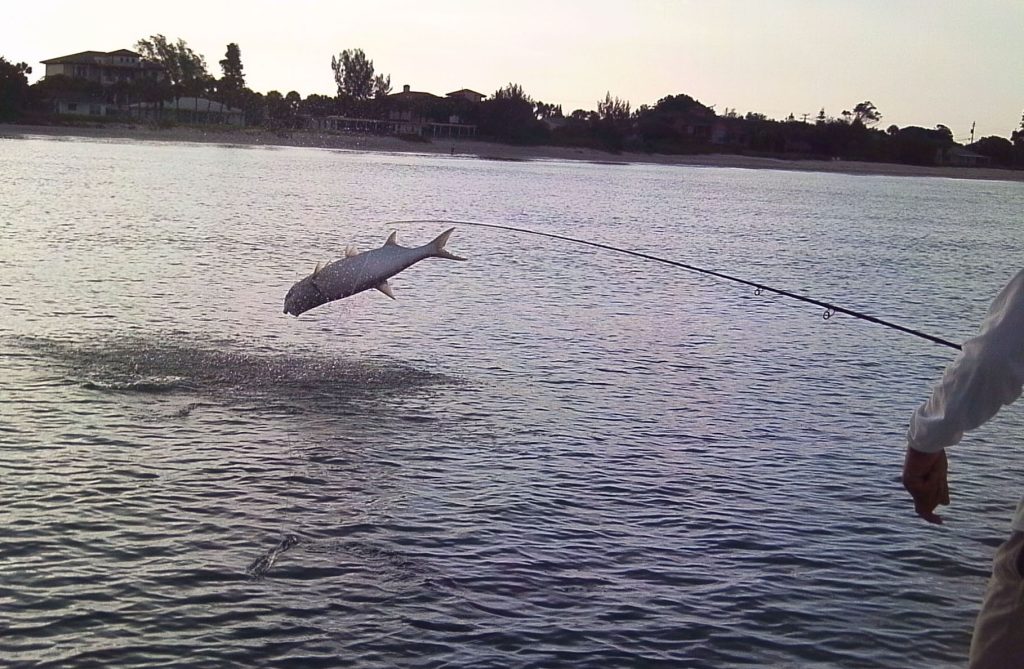
Fly fishing for tarpon in Sarasota!
This article will thoroughly cover fly fishing for tarpon in Sarasota. Tarpon are considered by many to be the ultimate game fish species, and for good reason. They grow very large, averaging around 75 pounds in the Sarasota area. They are a beautiful fish that when hooked leaps high out of the water multiple times. They will test any anglers skill and determination.
Sarasota tarpon charter is $700
Contact Capt Kelly at (941) 376-0605 fishingstil@gmail.com
The vast majority of fish caught by anglers tarpon fishing in Sarasota will be mature fish, averaging 75 to 90 pounds, but with fish pushing 200 pounds a possibility. These are migrating fish that move through starting in very late April and into July. There are a few opportunities for juvenile tarpon in the rivers, but this is by no means a reliable opportunity.
Fly fishing for tarpon in Sarasota
Most of the tarpon fishing in Sarasota is done in the Gulf of Mexico out off of the area beaches and on the big sandbars regarding the passes. Late in the season, tarpon can be targeted inside Sarasota Bay on some of the deeper grass flats. This bite does not occur every year, but when it does it can be very productive and exciting as these fish are on the flats to feed.
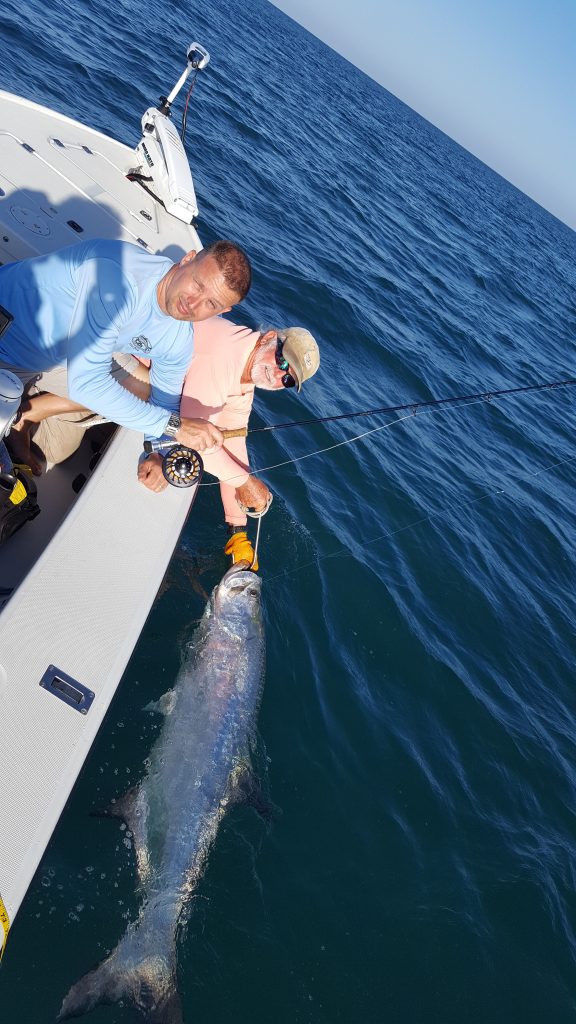
Schools of tarpon show up off of the Sarasota beaches in late April or early May depending on the year. They become more and more numerous, with the peak number occurring on the full moon in late June or early July depending on the year. Early in the season, tarpon are mostly encountered in larger schools. After the spawning occurs, these schools break up and fish split into smaller bunches, even into singles and doubles.
Best fly fishing tackle for tarpon
Anglers tarpon fishing in Sarasota need to use heavy tackle. Some anglers show up with a 10wt, and that really is not enough. A 12wt is a better choice as the chance to hook an extremely large tarpon is always present. Also, anglers are casting fairly heavy flies sometimes into the wind. Finally, it is best for the fish to use tackle heavy enough to subdue it in a reasonable amount of time.
Therefore, a 12wt outfit with a large capacity reel in a smooth drag is the best overall combination when fly fishing for tarpon in Sarasota. An intermediate sink tip or sinking line is best. While fish will often be seen on the surface, the take almost always occurs down in the water column. This is true even on shallow bars in 4 to 5 feet of water, the fly needs to get down a bit in order to draw a strike.
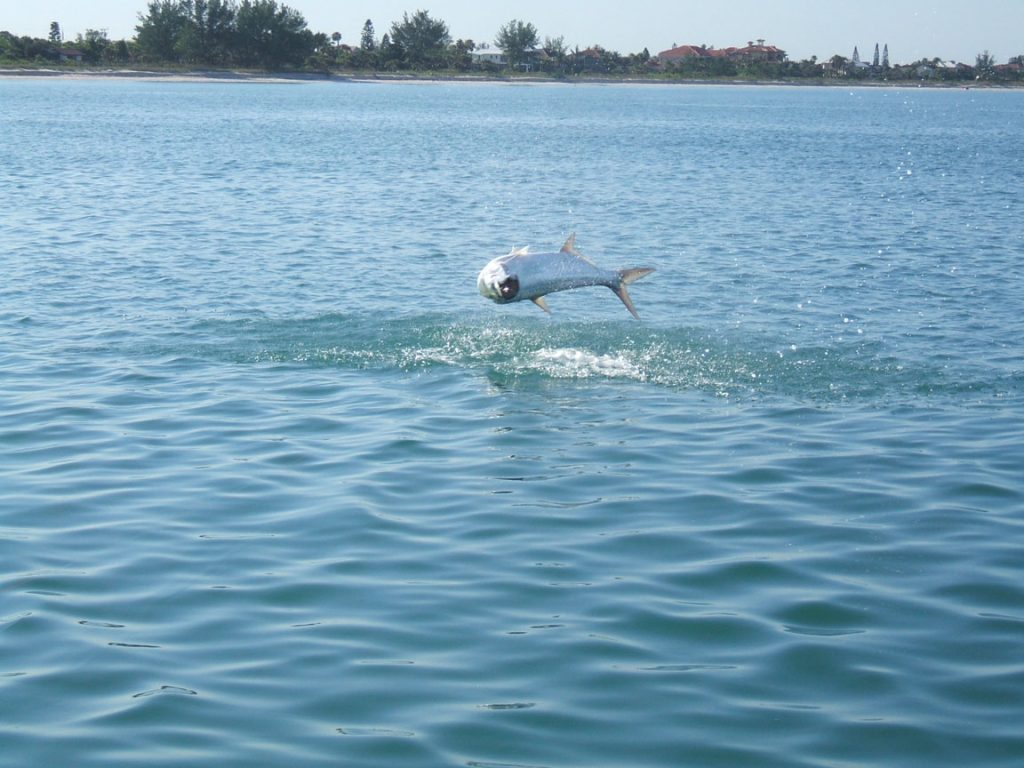
A 9 foot to 12 foot tapered tarpon leader completes the rig. This leader should have an 18 inch to 24 inch piece of 60 pound to 80 pound bite tippet. As with all fishing, anglers may have to go lighter on the tippet in order to draw a strike, understanding that it will be a bit more difficult to land the fish. Fly selection is not complicated, a selection of the standard tarpon flies such as black death, cockroach, deceivers, Puglisi flies, and Bunny flies will all produce. It really is more about presentation than the fly pattern.
Sarasota tarpon fishing techniques
Anglers tarpon fishing in Sarasota used two basic techniques; fishing schools in deeper water in fishing schools and smaller pods of fish in shallow water. The same tackle and flies can be used in both circumstances, with a few subtle differences.
The approach when targeting tarpon off of the Sarasota Beaches in deeper water is really fairly simple, though not at all easy. Anglers sit in the boat a couple hundred yards offshore and scan the water for signs of fish. On a call day, they are very easy to see when they break the surface. Obviously, if wind is present and a chop is on the water, this makes spotting them more difficult. However, the child does allow anglers to get closer to them.
Identifying the best tarpon schools
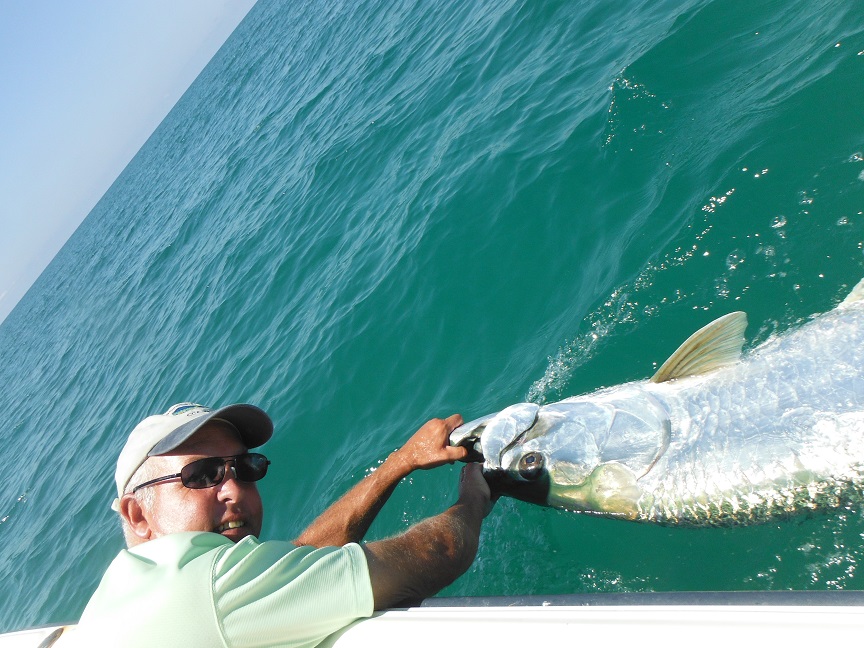
Anglers will encounter different types of schools out on the beaches. These are great hounding schools, moving schools, and laid up schools. The chances of success are higher with some than others in different approaches apply.
Greayhounding tarpon
Great hounding tarpon are tarpon that are high up in the water column, often with a good portion of their body exposed as they swim along. These fish are moving fast. While it is very exciting to see them cruising along like this, they are extremely difficult to get to bite, especially on fly. While these great hounding tarpon will occasionally settle down, for the most part it is best to let them go by and instead concentrate on other fish.
Slow moving tarpon
Slow-moving schools will definitely bite! These are schools of fish that are moving along at a relatively slow pace. When the sun is up, especially in shallow water, they can be seen even when not surfacing. Early in the morning, the fish must broach the water in order to be seen. The slower moving and lackadaisical looking the tarpon are, the better chance the angler has to catch one.
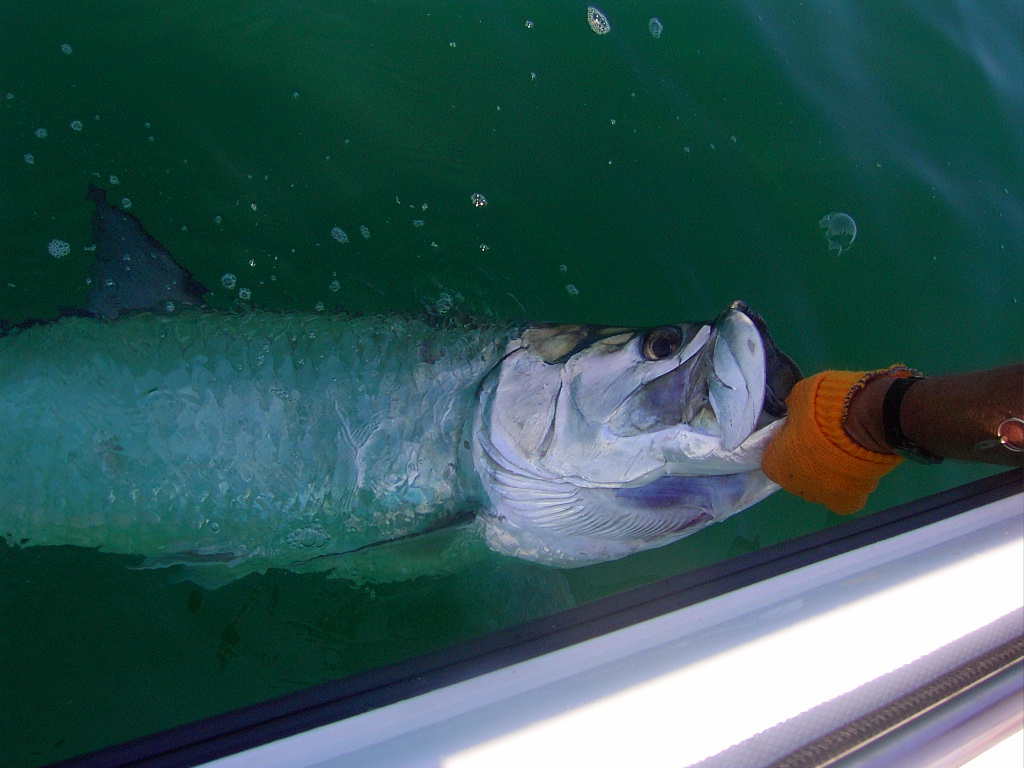
Boat positioning is very important when fishing these moving schools. The best approach is to be in front of the fish and off to the side about 45°. When the tarpon move into range, the cast is made in front of the fish in the fly is allowed to sink. The idea is to be pulling the fly away from the tarpon. This looks much more natural than a fly approaching a tarpon.
The reason for being 45° off to the side is that if the fish don’t take the angler can let them go by and then set up again further down the beach. If the tarpon run directly under the boat, especially in shallow water, it will be very difficult to get a fish in that particular school the bite.
Laid up (daisy-chaining) tarpon
The third type of school that anglers fishing for tarpon in Sarasota will encounter is a laid up or milling school. This is a school of tarpon that is sitting in one spot and not moving very much. They will often come to the surface swimming around in a circle, nose to tail. This is known as “Daisy Chaining”. This is the opportunity that every fly angler dreams of!
Anglers and countering one of the schools of laid up fish need to be patient and take their time when easing into position. They will spook and either take off or not bite. In most cases, the school will be moving north to south at a very slow speed. Therefore, the best approach is to set the boat up ahead of the school and hopefully be in position when it comes to the surface.
The fly is then cast to the edge of the school, allowed to sink, and retrieved back in. Is very important not to cast the line over top of the school of fish. This is called “lining” the tarpon and they will almost certainly bolt off in very dramatic fashion. At times the schools will surface and the exact same location for over an hour, giving fly anglers multiple opportunities. An electric trolling motor is used to make small adjustments and positioning. However, pushing the fish hard with the trolling motor is usually not a recipe for success.
Fly fishing for tarpon in Sarasota in shallow water
Tarpon can also be caught by anglers fly fishing in shallow water as well in Sarasota. This is especially true later in the year, by late June or early July, as the larger schools have spawned and broken up. This can occur on any bar or flat in water between 3 feet deep and 10 feet deep either along the beaches or more often at the mouth of the passes.
The best approach when fishing for tarpon in Sarasota in shallow water is to try to determine their path of movement and then set the boat up and wait for them. This can be frustrating, especially when other boats are present. However, one thing is for certain is that running around on the bar, even with the trolling motor, will put the fish down or cause them to not bite.
As the fish approach the anchored boat, whether it is a single fish, pod of a half dozen fish, or even a larger school, the technique is pretty much the same. The fly is cast out ahead of the lead fish, allowed to sink a second or two, then retrieved back in. This is very exciting is the angler will see the entire events unfold. Often times, the take occurs very close to the angler as the tarpon follows the fly in!
Anglers fishing this technique can experience a wide variety of action. There will be days when anglers will get a couple dozen legitimate shots a tarpon cruising by. On other days it may be tough just to find a single fish. However, experienced anglers realize that this is the challenge, and reward, of tarpon fishing.
Hooking and fighting a tarpon with a fly rod
The hooking and fighting process should be covered as well. Once the fly is cast out and allowed to sink, the angler keeps the rod in the line in one straight line, with no turns are angles at the rod tip. The fly is then stripped in using fairly steady but aggressive 12 inch to 18 inch strips. When a take occurs, the angler pulls sharply with the stripping hand getting the line tight, then raises the rod tip.
Anything can happen when the tarpon feels the sting of the hook. It may jump straight up out of the water or make a run, either towards the angler or away. Best scenario is where the tarpon makes a run away from the angler, taking up all the slack line that has occurred during stripping. This will also help set the hook.
Anytime a tarpon jumps, the angler should bow and point the rod tip right at the fish, throwing slack in the line. This violates the cardinal rule of fishing in most other situations. However, if the tarpon jumps and shakes his head violently on a tight line, the line will often break or the fly will come dislodged, something has to give.
Once the fish is hooked in the initial several jumps occur and the fish is hopefully still hooked, the hard part of the battle ensues. It is important to fight the fish with the lower part of the rod and not the rod tip. The rod should be kept below the horizon. Tarpon hooked in deeper water will often make circles and it can be difficult putting enough pressure on them, but the angler should try as much as possible. It really is important to try to land the tarpon in the shortest amount of time possible, in order to facilitate a safe release.
In conclusion, this article on fly fishing for tarpon in Sarasota will help anglers understand the tackle and techniques required as well is the challenge involved, and catching the fish of a lifetime!